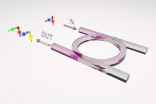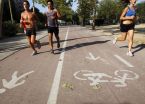(Press-News.org) WASHINGTON, Oct. 2, 2014—Commercial devices capable of encrypting information in unbreakable codes exist today, thanks to recent quantum optics advances, especially the generation of photon pairs—tiny entangled particles of light. Now, an international team of researchers led by professor Roberto Morandotti of INRS-EMT in Canada, is introducing a new method to achieve a different type of photon pair source that fits into the tiny space of a computer chip.
The team's method, which generates "mixed up" photon pairs from devices that are less than one square millimeter in area, could form the core of the next-generation of quantum optical communication and computing technology. The research will be presented at The Optical Society's (OSA) 98th Annual Meeting, Frontiers in Optics, being held Oct. 19-23 in Tucson, Arizona, USA.
One of the properties of light exploited within quantum optics is "photon polarization," which is essentially the direction in which the electric field associated with the photon oscillates. The research team set out to find a way to directly "mix up," or cross-polarize, the photons via a nonlinear optical process on a chip.
"While several efforts have been devoted to develop on-chip sources of polarization-entangled photons, the process typically used to generate these photons only allows the generation of photons with the same polarization as the laser beam used to pump the device — either both horizontal or vertical — after which entanglement can be achieved by accurately mixing these states. Now, we have found a way to directly generate cross-polarized photon pairs," says Lucia Caspani, a postdoctoral fellow at INRS-EMT and co-author of the Frontiers in Optics paper.
To generate the cross-polarized photons, Caspani and colleagues used two different laser beams at different wavelengths —one vertically polarized and another horizontally polarized. The approach, however, came with a potential pitfall: the classical process between the two pump beams could destroy the photons' fragile quantum state.
To address this challenge, the team, which also includes researchers from RMIT University in Australia and City University of Hong Kong, pioneered a new approach based on a micro-ring resonator—a tiny optical cavity with a diameter on the order of tens to hundreds of micrometers—that operates in such a way that energy conservation constraints suppress classical effects while amplifying quantum processes.
While a similar suppression of classical effects has been observed in gas vapors and complex micro-structured fibers, this is the first time it has been reported on a chip, thus opening a clear route for building scalable integrated devices.
"Our approach opens the door to directly mixing different polarizations on a chip," Caspani points out. "At very low power, our device directly generates photon pairs with orthogonal polarizations, which can be exploited for quantum communication and computing protocols."
The fabrication process of the chip is also compatible with that currently used for electronic chips. "It enables a future coexistence of our device with standard integrated circuits," says Caspani, which is a fundamental requirement for the widespread adoption of optical quantum technologies.
Presentation FTu2A.2, "Direct Generation of Orthogonally Polarized Photon Pairs via Spontaneous Non-Degenerate FWM on a Chip," takes place Tuesday, Oct. 21 at 11 a.m. MST at the Arizona Ballroom, Salon 8 at the JW Marriott Tucson Starr Pass Resort in Tucson.
INFORMATION:
PRESS REGISTRATION: A press room for credentialed press and analysts will be located in the Marriott, Sunday through Thursday, Oct. 19-23. Those interested in obtaining a press badge for FiO should contact OSA's Lyndsay Meyer at 202.416.1435 or lmeyer@osa.org.
About FiO/LS
Frontiers in Optics (FiO) 2014 is The Optical Society's (OSA) 98th Annual Meeting and is being held together with Laser Science, the 30th annual meeting of the American Physical Society (APS) Division of Laser Science (DLS). The two meetings unite the OSA and APS communities for five days of quality, cutting-edge presentations, fascinating invited speakers and a variety of special events spanning a broad range of topics in optics and photonics—the science of light—across the disciplines of physics, biology and chemistry. An exhibit floor featuring leading optics companies will further enhance the meeting. More information at http://www.FrontiersinOptics.org.
VIDEO:
A new study suggests ibuprofen can make old lungs look young. In lab tests, daily ibuprofen lowered lung inflammation in elderly mice. The research and its implications are described by...
Click here for more information.
COLUMBUS, Ohio – New research shows that the lungs become more inflammatory with age and that ibuprofen can lower that inflammation.
In fact, immune cells from old mouse lungs fought tuberculosis bacteria as effectively as cells from young mice after ...
Grandparents can significantly influence parents' decisions to have additional children and the well-being of grandchildren, according to a recent study completed at the University of Eastern Finland.
In his PhD study, Dr Antti O. Tanskanen observed that grandparents' help with childcare and emotional support are linked to mothers' willingness to have a second or a third child. Furthermore, parents of small children who obtain support from paternal grandparents are also more likely to have additional children. The involvement of maternal grandparents in the lives of their ...
Bethesda, MD (Oct. 2, 2014) — Nonsteroidal anti-inflammatory drugs (NSAIDs) — such as ibuprofen and aspirin — increase one's risk of upper gastrointestinal bleeding. When taken in combination with other drugs, this risk is significantly higher, according to new research appearing in the October issue of Gastroenterology, the official journal of the American Gastroenterological Association.
"These findings may help clinicians tailor therapy to minimize upper gastrointestinal bleeding, and are especially valuable in elderly patients who are likely to use multiple drugs ...
The bond between humans and dogs is strong and ancient. From being the protector of the first herds in a faithful pet, dogs and people share many aspects of life. The relationship between the two species has been studied by psychologists, anthropologists, ethnologists and also by genetic and molecular biologists. In this sense, dogs are a great model for understanding the causes of human diseases, especially cancer.
Unlike other mammals used in research, dogs develop cancer spontaneously as humans do and cancer is the most common cause of death in this species. The dog ...
This news release is available in French, Spanish and German.
Low digital skills and competences among school pupils and the need to integrate effective use of information and communication technologies into teacher training are among the most pressing challenges faced by European school education today, according to a report published by the European Commission and the New Media Consortium, a US-based not-for-profit body bringing together experts in education technology. The first-ever Horizon Report Europe: 2014 Schools edition outlines the trends and technological ...
A study analysing the positive and negative effects of energy drinks on athletes has seen that, although in principle their sports performance was seen to improve by between 3% and 7%, there was also an increase in the frequency of insomnia, nervousness and the level of stimulation in the hours following competition.
The consumption of energy drinks has increased in recent years. In the case of athletes, the use of them before practising sport has also risen: more than 50% take them during training and even before competitions.
A four-year study carried out by experts ...
This news release is available in Spanish. According to a recent paper published by the researchers Aritz Urdampilleta-Otegui, PhD in Physical Education and Sports and lecturer in the Department of Physical and Sports Education of the UPV/EHU-University of the Basque Country and at the Government of the Basque Autonomous Community (region), and Saioa Gómez-Zorita, PhD in Pharmacy and Food Sciences and researcher at the UPV/EHU's Department of Pharmacy and Food Sciences, it is necessary to control the administering of drugs that interact with the foods consumed and which ...
Barely perceptible low-frequency signals nevertheless activate measurable responses in our auditory circuits. Neurobiologists at Ludwig-Maximilians-Universitaet (LMU) in Munich have now characterized the remarkable impact of low-frequency sounds on the inner ear.
The human auditory system appears to be poorly adapted to the perception of low-frequency sound waves, as hearing thresholds become markedly higher for frequencies lower than about 250 Hz. Yet sensory cells do react to pressure waves with frequencies below 100 Hz, as revealed by the fact that such signals actually ...
A new test developed by researchers from the University of Manchester could revolutionise the discovery of new prescription drugs. The test will help determine which drugs are unlikely to work at an early stage, speeding up the time it takes to make safe and effective medicines available. The findings are published online in the journal Metabolomics.
The Pharmaceuticals industry is worth billions of dollars a year. The main source of prescription medicines comes from what are known as 'small molecule' drugs, such as statins and antibiotics.
The main problem for ...
AUDIO:
These are gray snapper larval growls recorded in the field.
Click here for more information.
MIAMI – A new study from researchers at the University of Miami (UM) Rosenstiel School of Marine and Atmospheric Science is the first to document that fish larvae produce sound. These "knock" and "growl" sounds may help small larvae maintain group cohesion in the dark.
"Although many adult fishes produce sounds, no one has previously considered that larvae, too, may be sound ...





